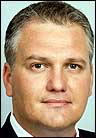Following the completion of a pilot at its manufacturing site in Owatonna, Minn., architectural glass fabricator Viracon is rolling out a company-wide Wi-Fi-based active RFID real-time location system (RTLS) to locate thousands of its glass carriers as they move through production.
The system, provided by AeroScout, is already being employed to track, monitor and manage all glass carriers throughout Viracon’s 1-million-square-foot campus in Minnesota. By August 2008, the company intends to deploy the system at its two other facilities, located in Statesboro, Ga., and St. George, Utah.
Viracon, one of the nation’s largest architectural glass fabricators, designs windows for large commercial buildings, such as the Freedom Tower in New York City, as well as smaller projects. The company customizes and sells 50 million square feet of glass annually, processing hundreds of orders at its three sites at any given time. At the Minnesota location, orders are typically transported on carriers to and from up to six stations, so they can then be cut, coated, laminated or silk-screened. The carriers—large metal frames on wheels—may hold just one or two sheets of glass for a single order, while others could hold many more than that for a larger order.
Hundreds of carriers often pass back and forth the between the three buildings on the Owatonna campus, says Todd Schelling, Viracon’s production manager. “It’s very much the opposite of an assembly line,” he says. Instead of following a predictable path through assembly, the glass is wheeled from one station to another in variable patterns, depending on the custom work being performed. For that reason, locating carriers can be challenging.
Until it launched an RFID-based pilot in the fall of 2007, the company utilized a handheld Intermec SF51 mobile bar-code scanner to track carrier movements. When a carrier was first loaded, a bar-coded ID label was attached to each piece of glass. The glass pieces’ labels were scanned, along with a bar-code ID label attached to the carrier, linking them to a customer’s order in Viracon’s back-end inventory-management system.
When the carrier was wheeled to a station for processing, an employee at that station would scan the ID number on the carrier to update the system regarding the order’s location. Employees scanned the carriers only about 60 percent of the time, however, so when workers searched for a specific order, they sometimes needed to walk the length of an entire assembly floor looking for it. If the carrier still could not be found, Viracon then had to reintroduce that order and restart the manufacturing process from scratch. If the company later located the missing carrier, the partially processed glass it contained was discarded.
Viracon looked into an RFID solution for about a year, says Matt Miesner, the company’s process-improvement project leader, and found that passive RFID tags would not operate as well as active RFID tags in its environment. Therefore, in the third quarter of 2007, Viracon began piloting AeroScout’s Wi-Fi-based 2.4 GHz RFID system. The company installed about 80 Cisco Wi-Fi access points throughout one of the three buildings on campus, and also attached AeroScout T2EB Industrial Tags to 500 metal carriers. The tags, powered by a battery with an eight-year life span, offer a read range of 450 feet.
If a carrier is standing still, its tag transmits its ID number only about once every half hour. Once the cart moves, however, a motion sensor in the tag instructs that tag to beacon every few seconds while the cart is in motion. Cisco appliance software allows the access points to pinpoint a tag’s location within about 15 feet. That data is stored on Viracon’s inventory-management database and used by AeroScout’s MobileView software to enable workers to locate a specific carrier by displaying an icon on a map of the assembly floor on their PC screen.
Amir Ben-Assa, AeroScout’s industry solutions marketing director, says the pilot was successful and led to full deployment at all three buildings on Viracon’s Owatonna campus, which began at the end of 2007. According to Ben-Assa, the company found that search time, per carrier, was reduced from an average of 15 to 30 minutes to less than one minute. “The goal was to automate the process, reduce search time and eliminate lost carriers,” he says, “and all those goals were met.”
The greatest challenge for the installation, Ben-Assa says, was the possibility of RF interference due to the presence of metals and high ceilings, but the use of Wi-Fi active tags and access points made it possible to transmit signals effectively in such an environment. With the deployment—which was completed this month at the Owatonna facility—Viracon is using about 5,000 AeroScout Wi-Fi-based active RFID tags mounted on the carriers.
Miesner says the company has completed a cost/benefit analysis and determined how much the system will reduce search time, as well as increase the throughput and reduction of scrapping glass. He expects the quantity of searches to be reduced from 40 percent of carriers to less than 1 percent, and says the company anticipates reducing reorders due to missing carriers by 50 to 70 percent. “We anticipate an ROI in about a year,” Miesner says.


